In This Issue :
- What is the Low Vision Education Program?
- The Many Faces of Low Vision
- NEHEP Partners Place Emphasis on Low Vision Education
- Low Vision Travelling Exhibit Tours Shopping Malls
- Living with Low Vision
- Low Vision PSA's
- Healthy People 2010
The Low Vision Education Program
NEHEP Partners Welcome New Program
With about 14 million Americans-one of every 20-having difficulty seeing well, the National Eye Institute has launched a Low Vision Education Program outlining steps people can take to make the most of their remaining sight. The new program brings the message that information and help are available to people with low vision and their families.
"The Low Vision Education Program will help educate people with low vision that they can improve their quality of life and learn how to use their remaining vision more effectively," said NEI Director Dr. Carl Kupfer at the program's launch at the National Press Club in Washington, DC.
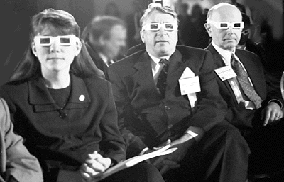
No, this is not a 3-D movie! attendees at the launch of the
Low Vision Education Program wear special glasses that
simulate visual impairment.
The launch of the program was greeted by more than 100 people representing a cross- section of many groups, including those with disabilities and their families, vision related organizations, low vision vendors, the media; and the public. During launch activities, several NEHEP Partners voiced strong support for the program, including Dr. Robert Christiansen, Chairman of the American Academy of Ophthalmology's (AAO) Vision Rehabilitation Committee; Dr. Larry Spitzberg, the American Optometric Association's (AOA) Immediate Past Chairman of the Low Vision Section; Bryan Gerritsen of the Association for Education and Rehabilitation of the Blind and Visually Impaired; and Dale Otto, president and chief executive officer of the Columbia Lighthouse for the Blind in Washington, DC. A demonstration area, arranged and staffed by the Columbia Lighthouse for the Blind, featured closed-circuit televisions, magnifiers, and a variety of assistive devices. The NEI also unveiled its Low Vision Traveling Exhibit, which will tour shopping malls nationwide and increase public awareness about low vision through an interactive touch screen and other displays.
Low vision is broadly defined as a visual impairment, not corrected by standard glasses, contact lenses, medicine, or surgery, that interferes with the ability to perform everyday activities. It primarily affects people over age 65 and other higher risk populations, such as Hispanics and African Americans, who may lose their vision at an earlier age. Most people develop low vision because of eye diseases such as age-related macular degeneration, which is the cause of nearly half of all cases of low vision and the leading cause of severe visual impairment in Americans 60 years of age and older. Other major causes of low vision are glaucoma and diabetic retinopathy.
Low Vision Makes Life Difficult
"People with low vision have difficulty with everyday activities, such as reading the newspaper, recognizing familiar faces, or working at their jobs," Dr. Kupfer said. "Many people with low vision become socially isolated because they can no longer enjoy activities such as playing cards or going to a movie. The health of people with low vision may be compromised when they cannot recognize medications or read labels or nutritional information on food packages. Visual impairment can lead to a loss of independence and affect people's ability to move about safely, make decisions, and communicate with others.
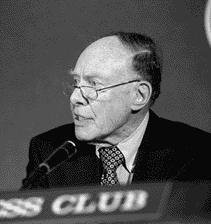
Visual impairment can lead to loss of
independence and affect people's
ability to move about safely, make
decisions, and communicate with
others, said NEI Director, Dr. Carl Kupfer
"The major problem is that people with low vision often accept their condition and do not seek help," Dr. Kupfer said. "Sadly, many people feel low vision is a part of aging that they just have to learn to accept. But they should not accept the statement that nothing can be done about their low vision. The fact is that they can do something about it. People need to know that they are not alone and help exists."
Dr. Kupfer said the NEI conducted focus groups and interviews with people who live with low vision and talked with low vision service providers, educators, and experts. "We found that many people who could benefit from low vision services were not receiving them," he said. "Many health professionals did not know where to refer patients when there was nothing more they could do for them medically. Many people did know about vision rehabilitation services, and those who did often did not seek them because they did not perceive their vision to be poor enough to use them. Others with very poor vision assumed they had to be totally blind before they qualified for special services.
"This is where the Low Vision Education Program comes in," Dr. Kupfer said. "The program will help educate people with low vision that they can improve their quality of life and learn how to use their remaining vision more effectively."
Vision Rehabilitation Specialists
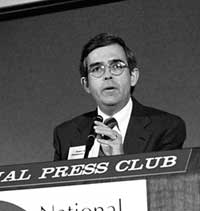
Vision rehabilitation specialists offer
devices, training and support, said
Dr. Robert Christiansen of the AAO.
For those with decreased vision, it should be an easy passage from the ophthalmologist or optometrist to the vision rehabilitation specialist, according to the AAO's Dr. Christiansen.
"I am trained to provide comprehensive eye care, examinations, medical care, and surgical care," Dr. Christiansen said. "But yet there are diseases and conditions which are still unfortunately and often tragically beyond the scope of our abilities to cure. Too often, our patients become very discouraged when they feel that they no longer can be helped with their vision challenges.
"But today's world offers assistance for many of the problems caused by decreased sight," Dr. Christiansen said. "As vision rehabilitation specialists, we offer devices, support, and training. After all of the medical and surgical specialists have completed their work, we offer help to people with visual impairment so they can continue to function in their homes, families, schools, and work."
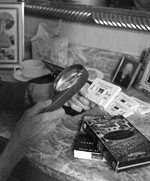
A magnifying glass can make
doing everyday tasks easier.
Dr. Christiansen addressed the roles of the AAO and AOA in providing vision rehabilitation. "The American Optometric Association and the American Academy of Ophthalmology are unified in our concern for the continued vision care of individuals in our country who can no longer be helped with traditional medical and surgical eye care," he said. "Our professional organizations are deeply committed to assuming the provision of rehabilitation services and assisting those with decreased vision. Sight is precious, and as vision rehabilitation specialists we work every day to help individuals with eye disease continue to use their remaining vision. It has been our opportunity to work together over the past year with a common goal in mind, to develop the means to provide care for those with decreased vision throughout the United States."
Assistance is Available
The AOA's Dr. Spitzberg said that between his organization and the AAO, "We have over 50,000 members serving over 7,000 communities. Assistance is available in almost every community and state for those who are limited by macular degeneration and other eye diseases. There is help, we are here, and we want the public and our professions to know that.
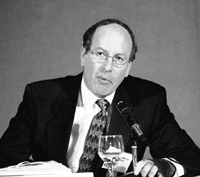
The AOA's Dr. Larry Spitzberg said his
organization and the AAO must be more
aware of what low vision is and that
patients must be referred to specialists
in vision rehabilitation.
"We must make our own professions more aware of what low vision is, and that patients with low vision must be referred to specialists in vision rehabilitation," Dr. Spitzberg said. "There are those physicians who may yet tell patients, 'There is nothing more that can be done.' But Dr. Christiansen and I will tell you that there is something that can be done. With continuing education and through articles and editorials in our journals, we are directly communicating to our colleagues to refer, to refer, to refer, or do some vision rehabilitation in their offices."
Dr. Spitzberg said that both the AOA and AAO have a privilege and responsibility to prescribe vision rehabilitation services to people with low vision. "It all starts with a comprehensive low vision evaluation," he said. "This evaluation contains an extensive patient history including visual functioning and an ocular examination that involves special tests to measure vision.
"People with low vision can then be trained to read, sometimes drive, sew, use a computer, and do many other activities of daily living," Dr. Spitzberg said. "Low vision aids and devices include magnifiers, stronger reading glasses, CCTV's, telemicroscopes, telescopes, filters and lighting, and training and practice."
Dr. Spitzberg noted the importance to both the AOA and AAO that people with low vision be treated and served using vision rehabilitation services under Medicare and other medical insurance plans. "Our organizations both want national uniform guidelines applied for this medical service, and we stand here together to represent this unity," he said. "These services treat persons with moderate impairments from 20/70 vision to the profoundly impaired."
Caring for the Whole Person
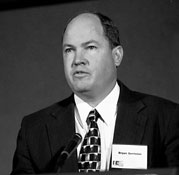
Bryan Gerritsen of the Association
for Education of the blind and Visually
Impaired said vision rehabilitation
"includes a whole array of services
-- it is caring for the whole person,
not just the eyes."
Bryan Gerritsen of the Association for Education and Rehabilitation of the Blind and Visually Impaired said while low vision services include a clinical examination by an ophthalmologist or optometrist and the prescription of optical devices, this is only the beginning of vision rehabilitation.
"Low vision services are more than magnifiers, strong reading glasses, or telescopic devices," he said. "Vision rehabilitation includes a whole array of services. It is caring for the whole person, not just their eyes. It includes helping people better adjust to their vision loss and providing counseling or involvement through support groups. It includes assessments of visual abilities for everyday tasks that are important to the individual, such as reading, writing, seeing a computer screen, watching TV, cooking, crocheting, and recreational activities. The low vision therapist helps a person learn to use vision both without and with prescribed low vision devices."
In addition to instruction in how to use prescribed low vision devices, Gerritsen said a typical rehabilitation plan includes instruction in how to use visual environmental cues. This instruction can take place both in a clinical setting and in a person's home, school, or job site. "A low vision therapist may offer suggestions on modifying a person's home or job site for improved lighting, enhanced contrast, and reduced glare," he said. "For instance, instead of using a clear drinking glass on a white sink in a bathroom with white walls, a dark brown or bright orange glass could be substituted for enhanced contrast. Improved lighting and a contrasting cutting board could be used in the kitchen, along with contrasting place mats and place settings.
"Think of a grandparent or friends that have low vision. And think of the difference that vision rehabilitation services might make in their lives!"
Assistive Technology and Adaptive Devices
The key to maximizing independence at home, school, and work among people who have low vision is using assistive technology in conjunction with other, sometimes more traditional devices, according to Dale Otto of the Columbia Lighthouse for the Blind.
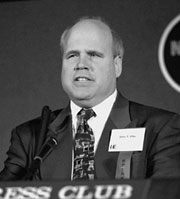
High Technology tools must be used
along with other, "low tech" devices
to provide maximum effectiveness,
said Dale Otto of the Columbia
Lighthouse for the Blind.
"Technology has revolutionized our lives," Otto said. "Assistive technology helps people maintain independent lifestyles and have made a significant impact in enabling people with visual impairment to continue to be productive and economically independent. Innovations in technology and appropriate training have the power to positively impact the astonishing 70 percent unemployment rate among people with vision loss."
But Otto said that it's important to remember that high tech tools must be used along with other, "low tech" devices to provide maximum effectiveness. "For instance, a student may have a computer with software that allows for speech output and screen magnification, but without magnifying lenses, that person cannot see the crosswalk sign on the corner.
"Or an employee may have been trained on the latest assistive technology software and, thanks to adaptive technology tools, can read text in word processing programs, databases, and magazines," he said. "This employee may also have binocular lenses attached to his glasses for seeing his boss from far away; bold, lined paper for taking notes; and large-print stickers for his keyboard."
Otto made reference to a person with low vision who might have a closed-circuit television at home for reading. "That person may also have a magnifying glass by the chair for easy use and a remote control with large numbers on the pad so it can be read more easily," he said. "This combination of low and high tech devices helps this person remain independent and productive and continue enjoying hobbies."
What is the Low Vision Education Program?

The Low Vision Education Program will convey positive and encouraging messages through a variety of ways, according to Rosemary Janiszewski, director of the NEI's National Eye Health Education Program, a partnership of over 60 public and private organizations united behind a nationwide effort to educate people about the importance of good eye health.
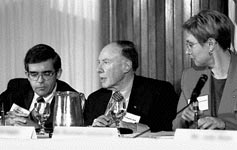
Dr. Robert Christiansen (left) of the AAO: Dr.
Carl Kupfer of the NEI; and Rosemary
Janiszewski of the NEI at the launch of the
Low Vision Education Program.
"Vision rehabilitation services can help make a big difference in the life of someone living with low vision and may bring back, or help them keep, their independence," Janiszewski said. "This is the message we need to convey to the public. We want to take the notion that low vision cannot be helped and replace it with messages of independence and self-reliance. We need to educate their families and friends, employers, and other key professionals about how they can support people who have low vision. The program will offer suggestions and information about services available to help people with low vision, leading to a better quality of life for them and those who care for them."
The Low Vision Education Program includes:

- A broad-based consumer media campaign.
This campaign, launched earlier this year, involves public service announcements for television, radio, and print with the theme that people can continue to do great things despite their vision loss. "Our objective is to help the media understand the issues surrounding low vision and the benefits of vision rehabilitation," said Janiszewski. "Members of the target audience get much of their health information through the media."
- Educational materials.
These materials include a free, large print booklet, What You Should Know About Low Vision, which reinforces the messages in the consumer media campaign. The booklet features stories of people living with low vision and provides information on the resources available to help those who cannot see as well as they once did. A complementary audiotape and videotape will be available later this year, as will a Spanish language version of the booklet.
- An outreach program.
Aimed at health care professionals, social service organizations, and groups that work with older adults, the outreach program will increase professional awareness of low vision issues and resources. It includes exhibits and presentations at professional meetings and conferences.
- Traveling exhibits. These low vision exhibits, featuring interactive multimedia touch screen programs, will be displayed in shopping malls nationwide to increase public awareness about low vision The exhibit will also allow community organizations to inform the public about low vision resources available locally. For more information about the Low Vision Education Program, contact Janiszewski at 301-496-5248, or visit the NEI's Low Vision Education Website at http://www.nei.nih.gov/nehep/
NEI Research in Low Vision
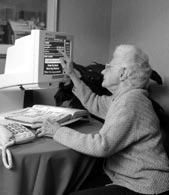
The National Eye Institute is furthering progress in the area of low vision research. As the leading source of vision research funds in the United States, it is supporting 26 low vision grants at a cost of $5.7 million in fiscal year 2000. Emerging technologies, such as the autofocus binocular low vision telescope, are constantly being exploited. Another key advance is the development of new technology, such as route planning database systems and personal guidance systems, to improve wayfinding for visually impaired people. Research has yielded several new methods of presenting magnified text on computer screens.
In addition to low vision research and the introduction of the Low Vision Education Program, the NEI is continuing its role of conducting and supporting eye disease research to reduce the leading causes of low vision through prevention, improved early detection, and effective treatment.
The Many Faces of Low Vision
Ask low vision therapist Bryan Gerritsen about working with people who can no longer see well and he has lots of stories to tell.
Gerritsen is Low Vision Chair of the Association for the Education and Rehabilitation of the Blind and Visually Impaired. He works for the Utah Division of Services for the Blind and Visually Impaired and spends most of his time at senior centers and vision clinics.

A Navajo Indian couple in front of their
mud hogan holding a magnifier, which
they use to work on her loom and
his saddles.
"I try to help all kinds of people," says Gerritsen. For example, how about the 101-year-old woman who told Gerritsen that she needed her vision "so she could just read her favorite Sunday Sally Forth comic strip." Or the rancher who wanted better vision so he could make sure that his ranch hands weren't loafing on the job.
Then there's the 84-year-old real estate agent recently voted Utah's top broker. With her vision gradually failing from age-related macular degeneration, she needed help reading her earnest money agreements and property contracts.
Gerritsen and others with the state agency fit people who have low vision with magnifying lenses, provide mobility training, or refer them to other professionals. He says that many of those who come to him are almost ready to give up, "so they're ecstatic when they find out there's help for them and their vision."
His clients come from all over the world and from all walks of life. He and noted University of Utah Medical Center ophthalmologist Dr. Robert Christiansen recently equipped Indonesian President Abdurrahman Wahid, who is nearly blind, with a speech device that converts highly sensitive documents into audio.
Out on the Utah State Navaho Reservation, Gerritsen and an associate fit mostly homebound elders with telescopic glasses for seeing their sheep, stand magnifiers for working on baskets and rugs, and special sunglasses for blocking the bright sun and whipping wind.
Sometimes solutions are simple. On a recent visit to the reservation, Gerritsen helped a man rig a rope from his hogan (a home made of mud bricks) to his backyard so he could find his way there and back. "Income and age aside, it's about finding things that can help people believe in themselves," Gerritsen says. "It's about helping people continue to be independent and feel that their lives are worthwhile."
NEHEP Partners Place Emphasis on Low Vision Education
On the heels of the National Eye Institute's launch of the Low Vision Public Education Program, four National Eye Health Education Program (NEHEP) Partner organizations are emphasizing low vision issues and education to professionals and consumers alike. This emphasis ranges from informative booklets to specialty education.
NEHEP is a coordinated partnership of more than 60 public and private organizations that conduct eye health education programs. Four NEHEP organizations-Lighthouse International, the National Association for Visually Handicapped, the American Foundation for the Blind, and the Association for the Education and Rehabilitation of the Blind and Visually Impaired-have a special interest in low vision education.

Lighthouse International
"Too often low vision services exist in a vacuum, and they shouldn't," says Dr. Cynthia Stuen, senior vice president for education at Lighthouse International. "The single focus provider must have access to an adequate referral network that allows low vision patients the full continuum of services they need to function independently."
The Lighthouse operates six centers in the New York area that provide comprehensive low vision rehabilitation services to providers and patients. The organization sponsors several continuing education courses for professionals, including: Low Vision Care in Pediatrics; Driving with Telescopes; and Clinical Low Vision Care. The Lighthouse publishes professional and consumer newsletters, brochures, and booklets with information about low vision, and has produced several recent publications on low vision, including
- Sound and Sight, for those with visual and hearing loss.
- Changes in the Aging Eye, with information about eye diseases.
- Family Involvement in Aging, with information for social workers and vocational rehabilitation professionals about the importance of involving families in vision rehabilitation.
- Resident Training Manual for ophthalmology resident students.
In studies funded in part by the NEI, researchers at the Lighthouse International's Arlene R. Gordon Research Institute are evaluating various aspects of low vision, including:
- The relationship among depression, vision loss, and rehabilitation.
- The relationship among life events, use of rehabilitation services, spirituality, and adaptation to low vision and accompanying psychosocial conflict.
- The success of a program that trains rehabilitation instructors in vision rehabilitation, which includes instruction on how to use low vision devices.
- A method of text display for low vision reading that allows the reader to control word presentation rate on a word-by-word basis.
For more information about Lighthouse International, contact the organization at 800-829-0500 or through e-mail at info@lighthouse.org, or visit its Website at http://www.lighthouse.org.
National Association for Visually Handicapped

The National Association for Visually Handicapped (NAVH) in New York City is active on many fronts of low vision awareness and support. The 45-year-old nonprofit national health agency was conceived by San Francisco native Lorraine Marchi, whose son was born with albinism, a genetic condition characterized by little or no pigment in the eyes, skin, and hair.
Marchi found little help for him and began support groups in the late 1950s for parents whose children had vision impairment but were not totally blind. Her efforts evolved into the NAVH, which today reaches people in 50 states and 95 countries, offering educational materials about sight. "NAVH does not care if someone is legally blind or partially sighted," Marchi said. "We try to help anyone who turns to us. It is important for people to know that there is an agency that serves the 'hard of seeing' but not totally blind. Too often, the public hears visual impairment and thinks 'blindness,' when in fact there are so many more afflicted with vision impairment than blindness."
Marchi said she became one of the first volunteer sources for large print children's textbooks. Learning to use an offset printing press in the duplicating department of a San Francisco hospital, Marchi established standards for large type materials.
Today, the NAVH offers a free-by-mail large print loan library of more than 7,000 titles, mostly donated by commercial publishers. The NAVH has also been instrumental in establishing more than 20 satellite low vision libraries at senior residences and nursing homes in California and Oregon, and most recently in New York's Upper Manhattan.
The agency trains staff and provides a wide selection of low vision aids, closed circuit televisions (CCTVs), hand-held scanners, special lamps, and large print books. One feature at NAVH headquarters is the "fun room," 600- square feet of space "chock full of goodies," Marchi says, referring to the CCTVs, adaptive devices, and other equipment used to assist those who have difficulty seeing well. The organization is also helping to evaluate a new type of lighting for the visually impaired.
For eye care and other health professionals, the NAVH sponsors medical and technical literature and lectures about low vision and other eye conditions. This year marks its 44th exhibiting at the American Academy of Ophthalmology's annual meeting, where it offers a course on the psychological effects of low vision. This year will also mark its fourth consecutive exhibiting at the American Optometric Association's annual meeting. The NAVH has several boards of advisers, including a 50-member ophthalmological group that reviews literature and provides advice. Members of the Optometric Advisory Board work closely with the agency in offering guidance and counsel to referrals.
"Low vision is the second impairment, next to hearing loss, that affects the greatest number of people," Marchi says. "I've seen many people who are visually impaired, including the legally blind, receive help through NAVH and become very successful. Our goal is to give people independence, hope, and dignity."
And what of her son? He graduated from college on the dean's list and is a registered conservator in the Probate Court of San Francisco and a licensed vocational nurse.
For more information about NAVH, contact the organization at 212-889-3141 or visit its Website at http://www.navh.org.
Association for Education and Rehabilitation of the Blind and Visually Impaired

The Association for Education and Rehabilitation of the Blind and Visually Impaired (AERBV)-a national organization of vision professionals, ranging from vision therapists to ophthalmologists- is helping to spread the low vision message.
"I'm sure everyone working in low vision services hears it every day-that an eye doctor or health care professional has told people with low vision that 'nothing more can be done,'" said Utah Low Vision Therapist Bryan Gerritsen. Gerritsen chairs the Low Vision Division, one of 14 specialty divisions within the AERBV. "We feel that we have a long way to go in educating not just patients, but professionals too," he said.
In March 2000, the AERBV joined forces with other agencies to distribute posters to senior centers across the country. Gerritsen said later this summer the AERBV plans to distribute these posters, which will help empower people with information about low vision and its causes, and treatments, to the offices of eye care professionals across the country. The organization plans to include the National Eye Institute publication, What You Should Know About Low Vision. "We think low vision is an important enough health issue in which to bring national attention," Gerritsen said.
The AERBV was formed in 1983 with the merging of two professional groups: the American Association of Workers for the Blind and the Association for the Education of the Visually Handicapped. The AERBV's Low Vision Division boasts 450 members, from Australia to Switzerland. Since 1995, the division has developed standards of behavior, a code of ethics, and a scope of practice statement for the emerging field of low vision therapy. The organization is also working toward national uniform Medicare reimbursement for the services of low vision therapists.
For more information about the AERBV, contact the organization at 703-823-9690 or through e-mail at aernet@laser.net, or visit its Website at http://www.aerbvi.org.
American Foundation for the Blind

The 79-year-old nonprofit American Foundation for the Blind (AFB) is a leading national resource for people who are blind or visually impaired. The Foundation creates and disseminates printed materials and educational curricula on many vision problems, including low vision.
One key focus of the AFB is the National Aging and Vision Network, a resource on vision rehabilitation for older adults. The Network began in 1996 with the goal of expanding the availability of vision rehabilitation services for older adults who are blind or visually impaired. At the Network's 1998 annual meeting of service providers for the blind and visually impaired, it formally adopted a "National Agenda on Vision and Aging," developed by more than 50 people representing 39 agencies and consumer organizations throughout the vision rehabilitation field.
"Many of us hope the National Agenda will lead to real systemic change that can improve the quality and quantity of services to older individuals who are visually impaired," said AFB Spokesperson Alberta Orr. "The purpose of the National Agenda is to shape public policies and public attitudes that enable these individuals to participate fully in all aspects of society."
A 12-member national steering committee-composed of representatives from vision, aging, and health organizations-oversees the Agenda. Working groups for each goal meet monthly by teleconference to plan, review progress, and develop the next steps toward achieving milestones. Some milestones achieved by the working groups include:
- Completing a draft of a self-advocacy curriculum.
- Developing a poster targeted to senior centers and eye care professionals.
- Achieving $14,850,000 in funding for Title VII, Chapter 2, Independent Living Services for Older Individuals Who Are Blind.
- Developing a draft fact sheet on employment of older persons with visual impairments.
- Developing a draft of a Nationally Standardized Minimum Data Set, including demographic, outcome, and satisfaction information, for use in programs that provide rehabilitation interventions for older adults with visual impairments.
"Mobilizing both professionals and consumers throughout the country around these critical issues is vital to the achievement of National Agenda goals," Orr said.
For more information about the AFB, contact the organization at 800-232-5463 or through e-mail at afbinfo@afb.org, or visit its Website at http://www.afb.org.
Low Vision Traveling Exhibit Tours Shopping Malls Nationwide

To help provide important information to people with low vision and their families and caregivers, the National Eye Institute has introduced a Low Vision Traveling Exhibit that will make its way to shopping malls around the country during the next few years.
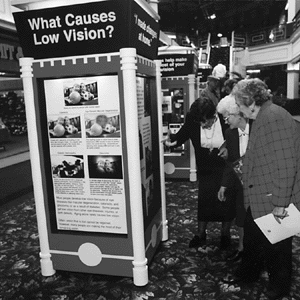
The exhibit, part of the NEI's Low Vision Education Program, is hosted by NEI grantee organizations and community groups. The exhibit, which made its debut in Birmingham, Alabama, in February, contains an interactive multimedia touch screen program; provides information on low vision materials and local services and resources; and displays aids and devices that help people with low vision live full lives. It includes five colorful kiosks and is designed to attract a cross-section of the population, from the young to senior citizens. Volunteers from the hosting organizations and groups staff the exhibit and help answer questions.
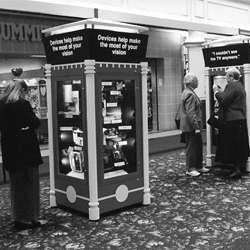
"The Low Vision Traveling Exhibit shows how an increasing number of people are living successfully with low vision," said Judith Stein, NEI's Associate Director for Communication, Health Education, and Public Liaison. "What can people do about their low vision? What can they do to maintain their quality of life? How can they make the most of their remaining vision? This exhibit can help answer these questions."


A highlight of the exhibit--an innovative interactive multimedia touch screen program--explains the causes of low vision; offers personal accounts of people living with low vision; and provides a self-assessment to help people determine if they or someone they know may have low vision. An animated character guides the audience through the program, and short videos provide hands-on advice. The multimedia touch screen program recently received an award for "improving access and eliminating health disparities" at Technology Games 2000, a national competition for developers of interactive health applications. Judges called the NEI's interactive program "an accessible application, with clean graphics and material at appropriate reading levels for its audiences." The Technology Games are sponsored by the DHHS, the Annenberg Public Policy Center, and the Annenberg School for Communication of the University of Pennsylvania.
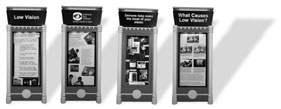
The NEI is looking at other ways the interactive program could be made accessible to consumers, such as through a stand-alone CD-ROM format and the NEI's Website.
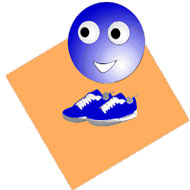
Want to Host the Exhibit?
The NEI is accepting requests from those wishing to host the Low Vision Traveling Exhibit. For more information, call Jean Horrigan at the NEI at 301-496-5248, contact Jean through e-mail at jh@nei.nih.gov, or visit the NEI's Low Vision Education Website. http://www.nei.nih.gov/nehep/
Living with Low Vision
Visual Rehabilitation Can Help Overcome Vision Loss
When retired nurse Mary Ruth "Smitty" Bailey woke up one morning 10 years ago and couldn't see if she had mail in her mailbox, she thought her life was over.
"I cried so long and so hard because I couldn't play music at church, and I couldn't teach Sunday school and I was good for nothing, I thought," says the 76-year-old from Leeds, Alabama, who was diagnosed with age-related macular degeneration (AMD), one of this country's leading causes of blindness.
Bailey was one of the three people with low vision who are featured as part of the NEI's Low Vision Education Program, which was launched last October at a press conference in Washington, DC. Outlook spoke to Bailey, Ernest Stribling, and José Koricki about how they cope with their visual impairment and live full lives.
Mary Bailey
In a videotape that was shown at the launch of the Low Vision Education Program, Bailey has baked "skillet cookies" and presents them to members of a support group she founded for people with visual impairments.
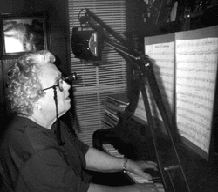
Mary Bailey plays the piano with the help of
a monocular mounted on her glasses.
"Did you see me when I jumped up and hollered 'Surprise!'" she asks, referring to her appearance in the videotape. "Well, I'm comedian number one, and I really enjoy my life today."
This is just one example of the life Bailey feels she recovered by seeking help at a low vision center, obtaining visual devices and relying on the support of those with similar impairments. Her support group meets once a month and enjoys many diverse activities, such as playing Bingo (with large faced cards, of course) and hearing speakers on various topics.
"I was just so excited to be a part of the Low Vision Education Program," she says. But for Bailey, the transition from her diagnosis of low vision to her acceptance of the condition wasn't easy. Only after numerous visits to eye care specialists, laser surgery on her left eye, vocational rehabilitation, and grieving from the loss of her husband five years ago did she really begin to adjust. "My husband was really my eyes," she says wistfully. "He gave me 20/20 eyesight."
Bailey, like some people with AMD, lost her vision suddenly. After reading the morning comics page, she got up to clear the table for lunch and couldn't see that the mail had been delivered. That evening she went to church, where she had taught Sunday school and played piano and organ for years, and couldn't see the preacher.
"My doctor examined my eyes and said, 'Sugar, you won't see any better than you're seeing today, but I'll be your doctor 'till the day you die,'" Bailey said. Bailey was later referred to the low vision center at the University of Alabama's School of Optometry, where she was prescribed eyeglasses with a telescopic lens. "With these, I can once again play music for my church," she says, and smiles. Bailey uses several devices that her low vision specialist provided, including a makeup case with a lighted mirror, an electric steamer that shuts off automatically, and an electric broom. "I learned how to sweep barefooted," she says. "I had to learn how to feel the dust, since I couldn't see it."
Ernest Stribling
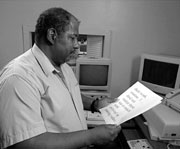
Ernest Stribling says that for people
with low vision, communication with
health care professionals is key.
Washington, DC, resident Ernest Stribling attends classes at the University of the District of Columbia, where he is working on a degree in social welfare. Since his vision loss several years ago from retinitis pigmentosa, Stribling listens to audiotapes to obtain the information he needs. Were it not for his tape recorder and closed-captioned television (CCTV), Stribling, 51, says that he wouldn't be making the good grades he is now and likely wouldn't be able to attend college.
"I'm more comfortable with listening than I was struggling to read printed material," he said. "I used to quit reading because my eyes would tear up, or I'd get tired and say 'The heck with it.'"
Stribling said that for people with low vision, open communication with health care professionals is key. "Stay abreast of your condition, since research is always being done and technology is always being improved," he said. "And don't isolate yourself to think that the world is over for you. It's not."
Stribling said he didn't know about low vision specialists "and the whole world of options they could open for me." Had he known about low vision specialists earlier, he said he may not have had to face the challenges at his job as a computer operator. "Because of my vision loss, my employer eventually had me doing menial jobs-I wasn't doing a job that I knew I was capable of doing," he said.
He also points out that when his vision was failing, vision aids, such as speech synthesizers, either weren't available or were too expensive. "Even now, the price of technology that can help people with low vision must be brought down and made more affordable," he said.
José Koricki
Cuban-born José Koricki was diagnosed with AMD in May 1998. After he had laser surgery on his right eye, the disease developed in his left. Four months later, he went to John Hopkins Medical Center in Baltimore, where he was part of a study for an experimental treatment for AMD. While the treatment did not restore his vision, it kept the disease from getting worse.
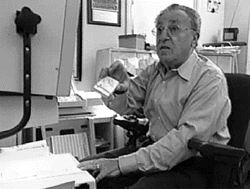
"There are many vision aids that can help
you if you have low vision," says José Koricki.
"At the beginning of my eye problems, I had a lot of 'Why me?' Why couldn't I get like a little infection on my finger nail or something like that?" he says. Low vision wasn't his first health crisis-the 66-year-old has been free of prostate cancer for five years. The same year he underwent prostate surgery, he had successful angioplasty. "I'm a very positive person," he says. "I've had to overcome quite a few illnesses. The thing is that I'm very upbeat and have never stopped working."
Koricki works out of his Potomac, Maryland, home, where he provides business advice to makers of sporting goods in South America. With help from aids like magnifiers and CCTV, he has regained some control over his environment. He gets up at the crack of dawn and walks four or five times a week.
"If you have eye problems like low vision, you can't give up," he said. "Keep trying. If you wait for some kind of miracle or sight-saving cure, it's not going to happen. There are many vision aids that can help you. Groups and organizations can also provide assistance."
One change, though, doesn't bother him too much: While he travels by airplane frequently for his job and can navigate successfully around airports without much assistance, he had to give up driving. "My wife drives me everywhere now," he says. "I call her Miss Daisy."
Art of the Eye II - An Exhibition on Vision
The Delta Gamma Foundation sponsors tours of an art collection featuring 52 multimedia works created by visually impaired professional artists. Upcoming dates and sites for Art of the Eye II are:
October 22-November 19, 2000
Presented by
Anchor Cneter for Blind Children
Shwayer Alumnae Chapter
Dallas, TX
February-March 2001
Presented by
Dallas Alumnae Chapter
Dallas, TX
Low Vision Public Service Announcements
An NEI-sponsored television public service announcement (PSA), featuring three famous artists who had low vision yet continued living active and full lives, is now airing on television stations across the country.
The PSA campaign is part of NEI's Low Vision Education Program designed to promote messages of hope for the 14 million Americans living with low vision. The PSA, which began airing earlier this year, is reaching millions of Americans, many of whom either have low vision or know someone who does. A print PSA, featuring several low vision devices and aids that can help people with low vision improve their quality of life, is appearing in magazines and journals. Radio PSAs are also airing across the country.
The television PSA features artwork by preeminent artists who had low vision. Edgar Degas suffered eye problems most of his life.
He had severe vision loss in his right eye after he served in the Franco-Prussian War and lost much of the central vision in his left eye. Still, he continued to work for many years. Claude Monet continued to paint for more than 15 years after his vision problems began, and painted his famous Water Lilies masterpieces following unsuccessful surgery for cataracts. Georgia O'Keeffe had macular degeneration, but painted for another decade and remained very active until her death at age 98.
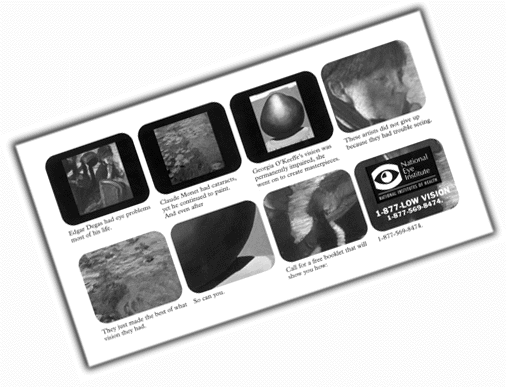
Disclaimer: Hilaire-Germain-Edgar Degas, At the Milliner's, Pastel on Paper The Museum of Modern Art, New York, Gift of Mrs. David Levy Georgia O'Keffe,
Black Rock with Blue Sky and White Clouds, Oil on Canvas, 1972 Alfred Stieglitz Collection, bequest of Georgia O'Keeffe
These three artists continued to produce some of this century's finest works of art despite their visual impairments. Today, people with low vision-with training, optical devices, and rehabilitation services-can continue living active, engaged, and fulfilling lives.
The print PSAs feature aids and devices designed to help those with low vision. It reads, "If you can't see well, here are a few things you should look into." They depict photographs of devices that can improve the quality of life for people with low vision, such as optically correct magnifying glasses, electronic devices that enlarge print, large type books and magazines, and glasses that magnify.
The TV, print, and radio PSAs inform people with low vision and their friends and families that there is hope and help for people living with the condition.
Help Reach Older People Who Are Experiencing Vision Loss!
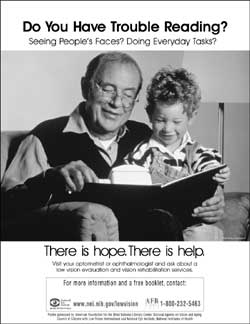
The population of older individuals who are experiencing vision problems is growing dramatically.
Many older people accept vision problems as a part of the aging process and in many instances, do not see their eye care professional or seek assistance from community resources.
To reach the aging population, a poster and booklet titled, What You Should Know About Low Vision were developed.
These materials can help reach thousands of older people who are beginning to experience vision problems and do not know what to do.
For copies of the poster and booklet, please contact:
Judy Scott, Director
American Foundation for the Blind Southwest
260 Treadway Plaza
Dallas, TX 75236
e-mail: jscott@afb.net
Tel:214-352-7222
Fax:214-352-3214
Vision Objectives Become Part of Nation's Health Agenda
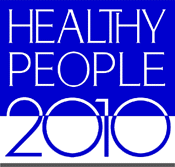
Vision objectives are included for the first time in Healthy People 2010, the nation's health agenda that identifies opportunities to improve the health of all Americans. "It's a real milestone," said Rosemary Janiszewski, Director of the National Eye Health Education Program. "This addition to Healthy People will finally put vision on the public health agenda." Most states and many localities use the Healthy People framework to guide local health policies and programs.
Healthy People 2010 features a chapter "devoted to recognizing the needs, and ddressing the multiple challenges, posed by the loss or impairment of the critical senses of vision and hearing." Vision objectives include increasing both the proportion of people who have regular dilated eye examinations and the number of children ages five and under who have vision screenings.
The vision and hearing communities attempted unsuccessfully more than 10 years ago to have vision and hearing issues included in the last report, Healthy People 2000. John Whitener of the American Optometric Association said the Healthy People 2010 vision objectives will help eye care professionals "get the message out that blindness can possibly be prevented by timely dilated eye examinations."

Public Health Service,
U.S. Department of Health and Human Services



